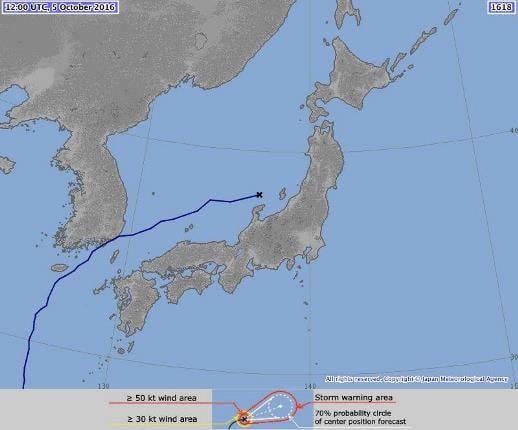Typhoon Chaba 2016
Status: Closed
| Type of posting | Posting date(EST): | Summary | Downloads |
|---|---|---|---|
| Landfall | 10/5/2016 1:40:00 PM |
|
Landfall | Summary
Posting Date: October 5, 2016, 1:40:00 PM
After battering Japan’s Okinawa Prefecture with high winds and heavy rain on Monday, October 3, Typhoon Chaba, while gradually weakening, moved north and east to Jeju Island and the southern coast of South Korea, where it made landfall between the cities of Busan and Ulsan at approximately 11:00 a.m. local time (02:00 UTC). Still weakening, Chaba then moved briskly east-northeast across the Sea of Japan toward the Hokuriku and Tohoku regions of mainland Japan.

Typhoon Chaba track, as of 9:00 p.m. local time (12:00 UTC) October 5. (Source: JMA)
Early Monday, Typhoon Chaba (known as “Typhoon No. 18” in Japan) reached super typhoon status, with the Joint Typhoon Warning Center (JTWC) reporting that wind speed reached 266 km/h (165 mph), the equivalent of a Category 5 hurricane. The Japan Meteorological Agency (JMA) reported that the central pressure bottomed at approximately 905 mb, which JMA considers to be a “violent” storm. Monday evening wind gusts of 216 km/h (134 mph) were recorded on the Japanese island of Kume, in the Okinawa Prefecture. (JMA and JTWC differed in their published storm tracks. While JMA—and most reports on the storm—indicated that Chaba did strike the Korean Peninsula, JTWC showed the storm bypassing the Korean mainland.)
Widespread Impacts
Typhoon Chaba delivered high winds and heavy rain from the Okinawa islands, southern Korean islands, and the lower region of the Korean peninsula to the Japan mainland. Throughout the impacted region, flash floods caused damage to residential and commercial property, as well as to roadways and many vehicles. Also, in some locales, downed power lines resulted in power outages. In addition, many flights were canceled, some local transportation was curtailed, and thousands of schools were closed.
Although wind gusts of more than 80 km/h (50 mph) were reported on Okinawa, the storm had taken a favorable turn before reaching the island prefecture, reducing its impact. Nonetheless, Chaba, one of the most powerful typhoons to affect the prefecture, closed Okinawa’s main airport, caused more than 800 people to be evacuated, and resulted in power outages affecting 4,000 households.
The South Korea island of Jeju, a popular tourist destination, received a direct hit from Chaba, with wind gusts reported at 200 km/h (124 mph). Jeju, as well as the southern South Korean cities of Busan and Ulsan, reportedly experienced wind gusts to 169 km/h (105 mph) and downpours of up to 600 millimeters (24 inches) between noon Tuesday and noon Wednesday. In Ulsan, Hyundai Motors stopped work at two of its five plants in the city. Power outages darkened more than 200,000 households in southern South Korea, according to Korea Electric Power Company, and forced the high-speed KTX train to suspend service.
Up to 200 millimeters (2 inches) per hour of rain was expected for broad areas of western and eastern Japan, as Typhoon Chaba moves across Kyushu Island; rainfall totals could reach 180 millimeters (7 inches) in some areas.
Exposure at Risk
Japan and South Korea have strict and well-enforced construction codes, although in both countries many existing structures predate the existence of these codes. Residential exposures are dominated by wood construction; non-wood residences primarily consist of steel and concrete. Modern wood construction typically demonstrates the best performance in typhoons among all wood constructions. However, damage to roof coverings and windows can allow wind-driven rain to enter and cause extensive damage to contents. Furthermore, dislodged external components can become wind-borne debris and cause damage to surrounding structures and glazing.
Larger multi-family apartment buildings and commercial and industrial structures are generally engineered and made of reinforced concrete or steel. Complete structural collapse of engineered buildings due to typhoons is extremely rare; damage is usually confined to nonstructural components, such as mechanical equipment, roofing, cladding, and windows. In Okinawa Prefecture, the dominant construction type is reinforced concrete, therefore significant damage to buildings is not expected.
A significant portion of industrial stock is of non-engineered light metal construction, which is one of the construction types most vulnerable to high winds. Low-rise, non-engineered commercial and industrial buildings usually perform similarly to single-family homes under typhoon conditions.